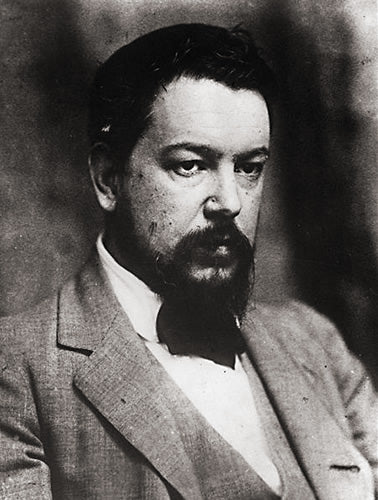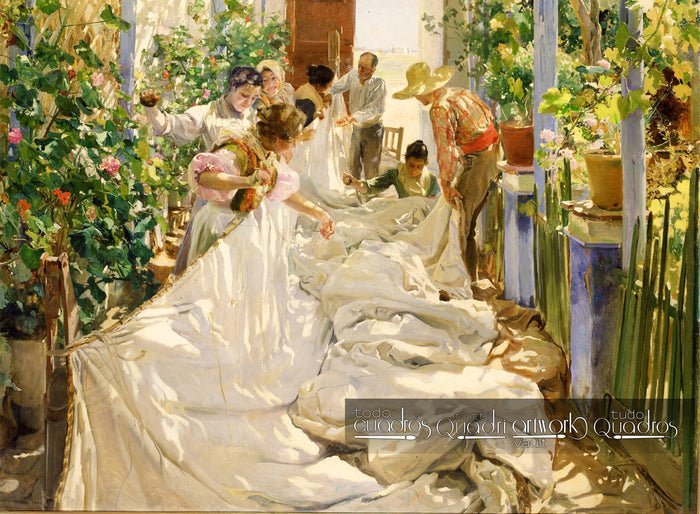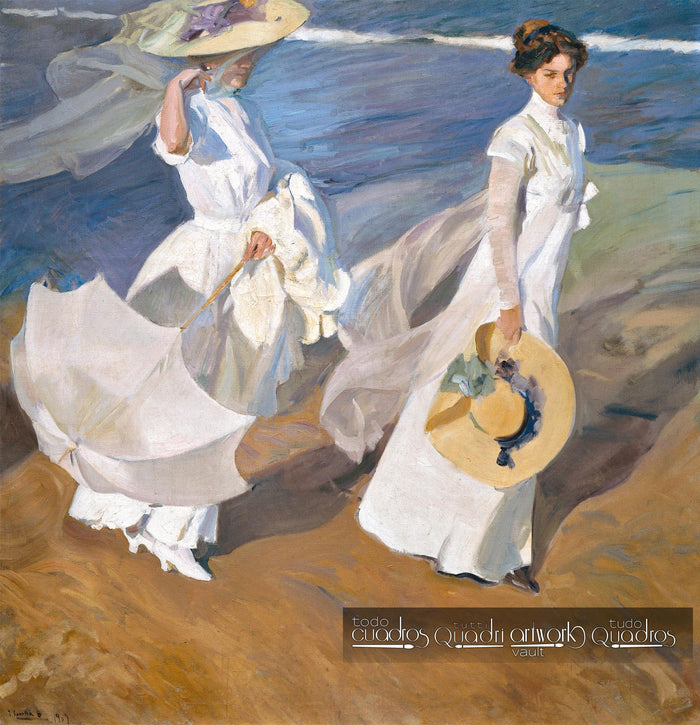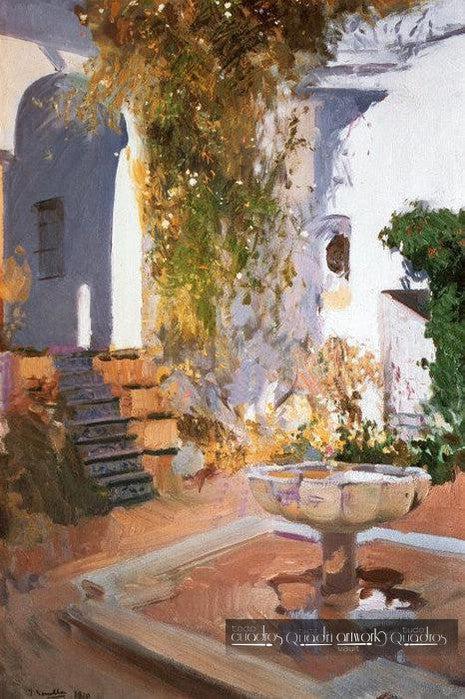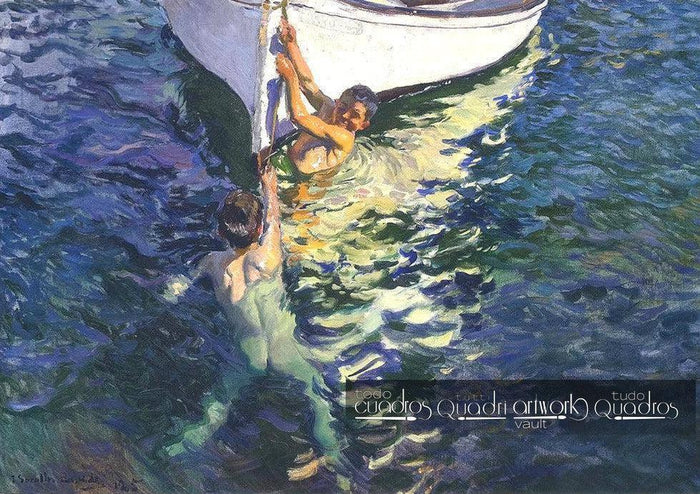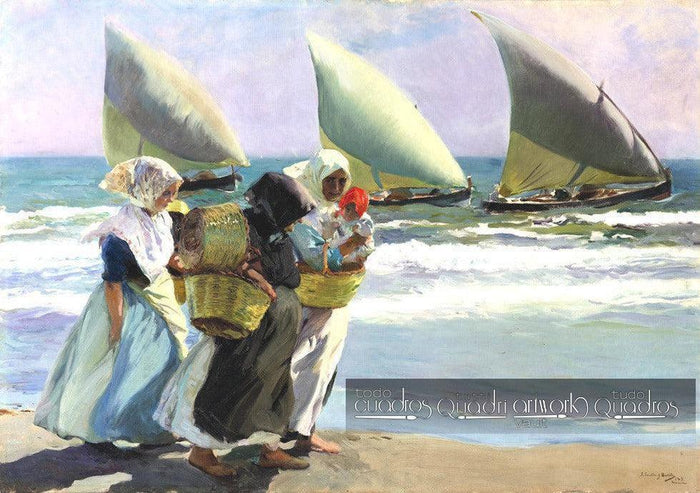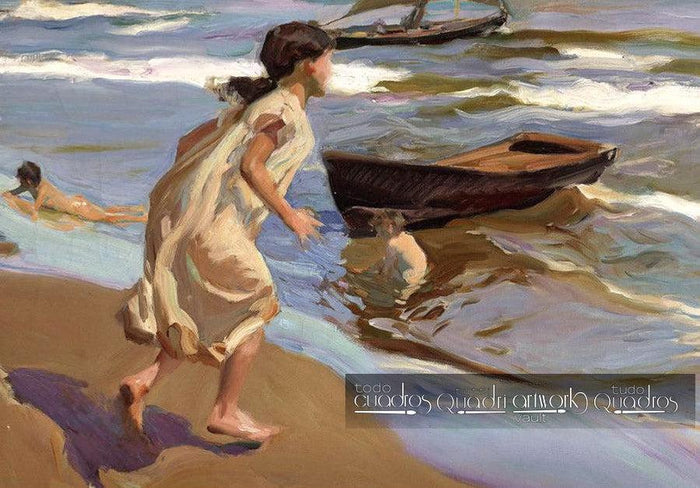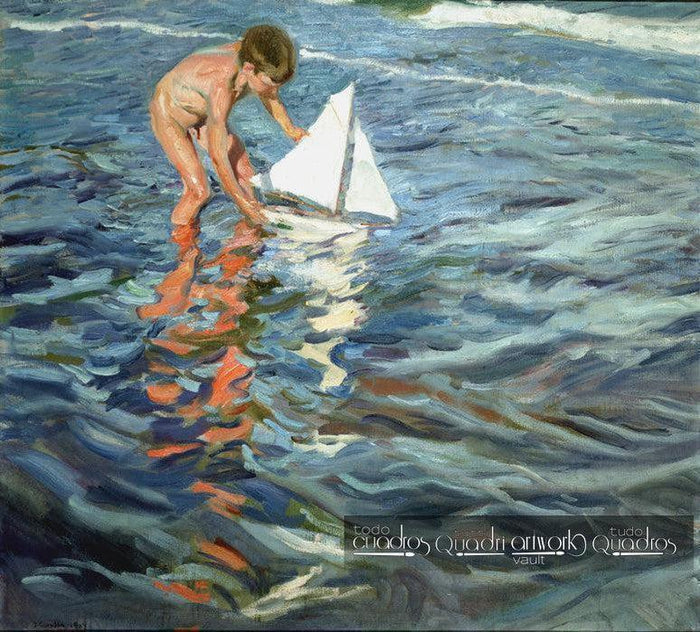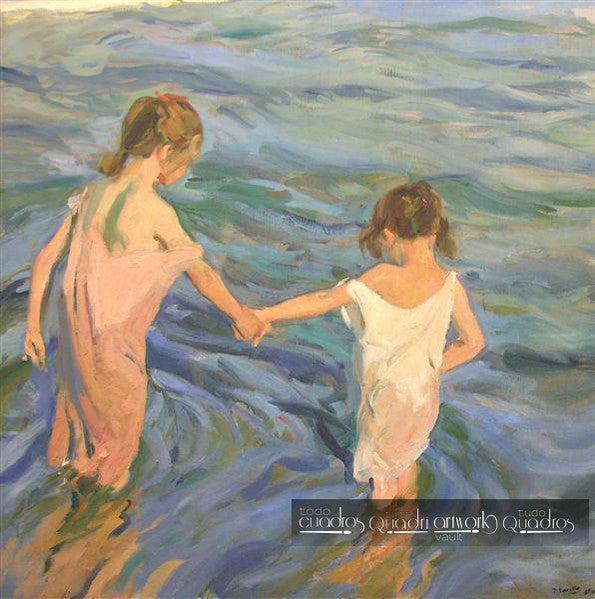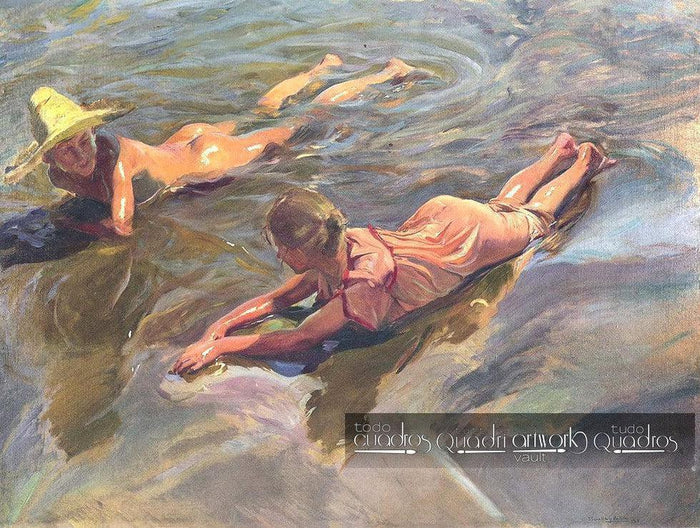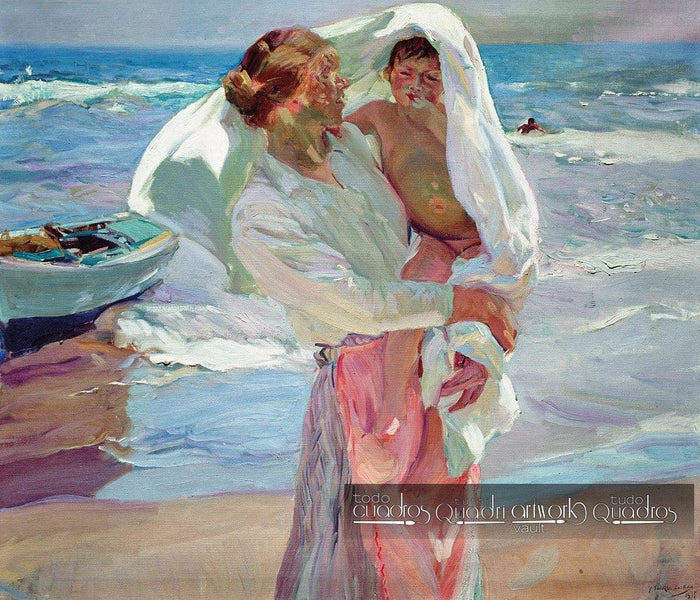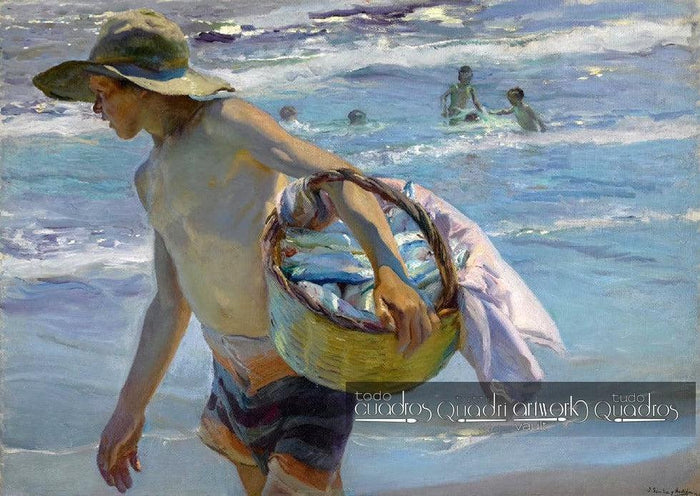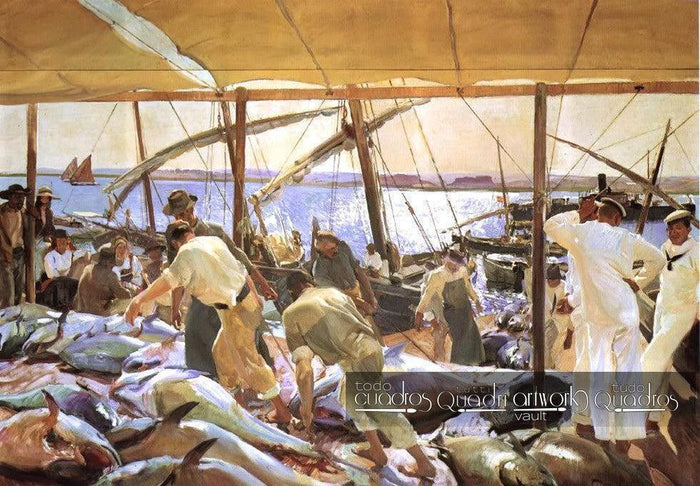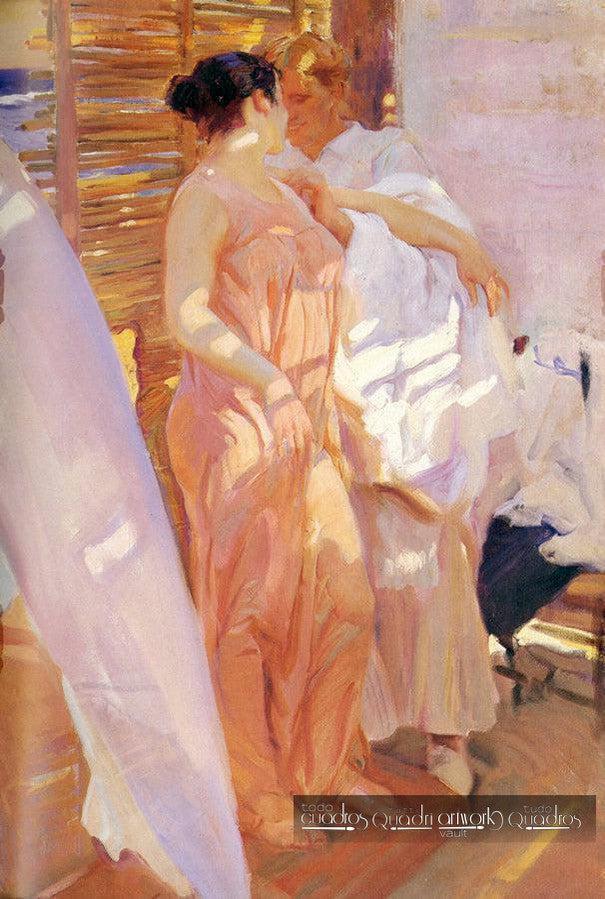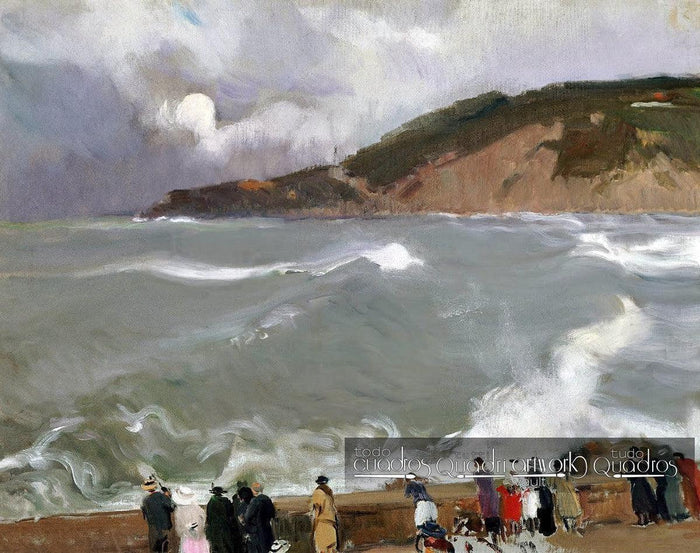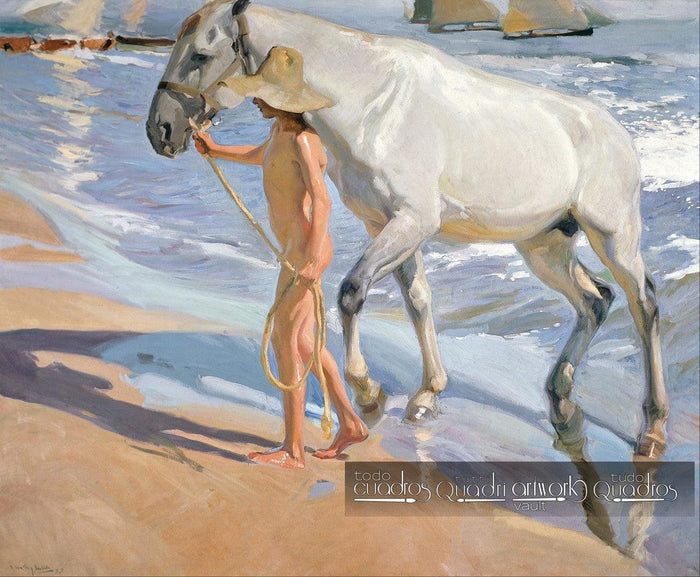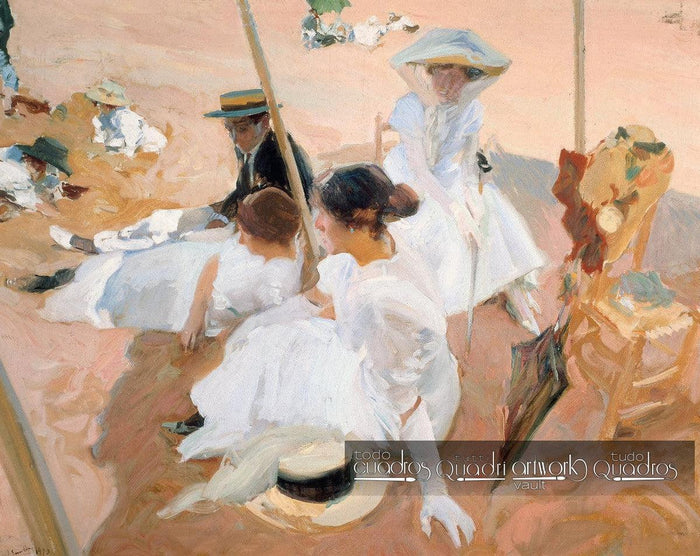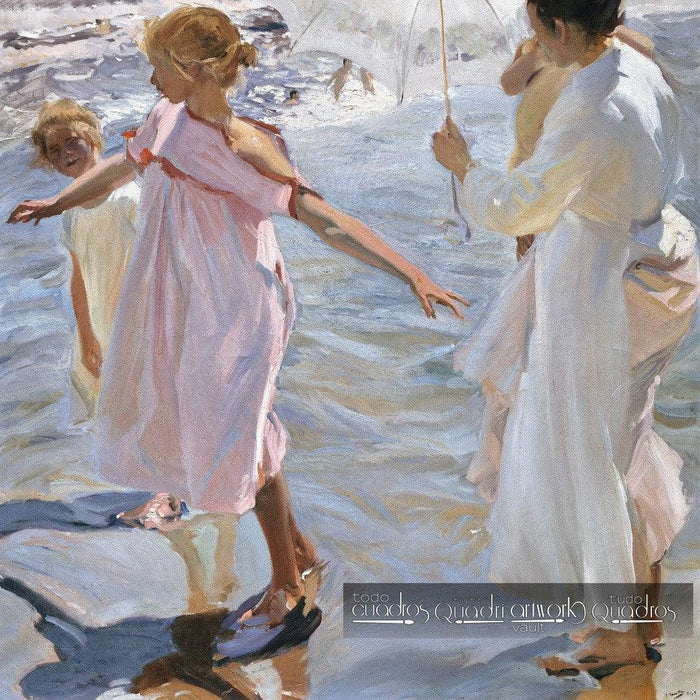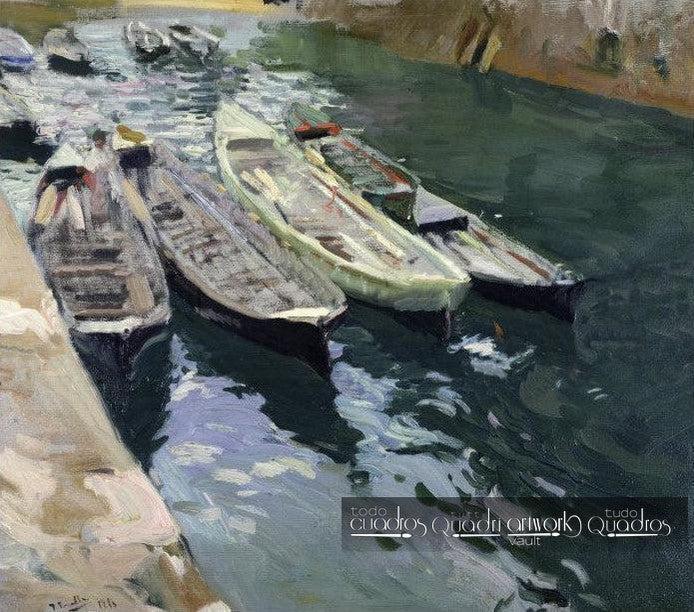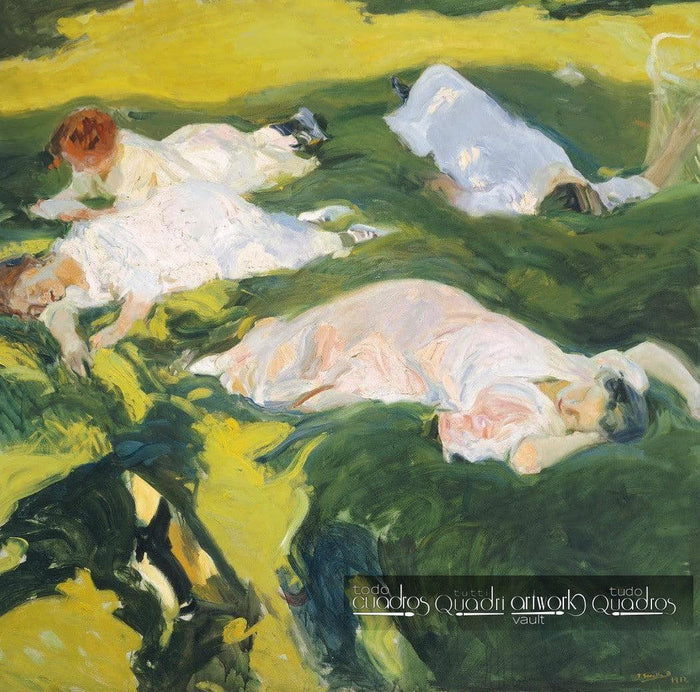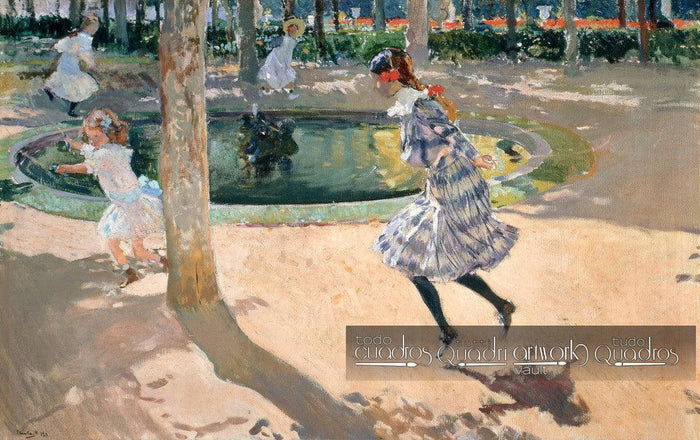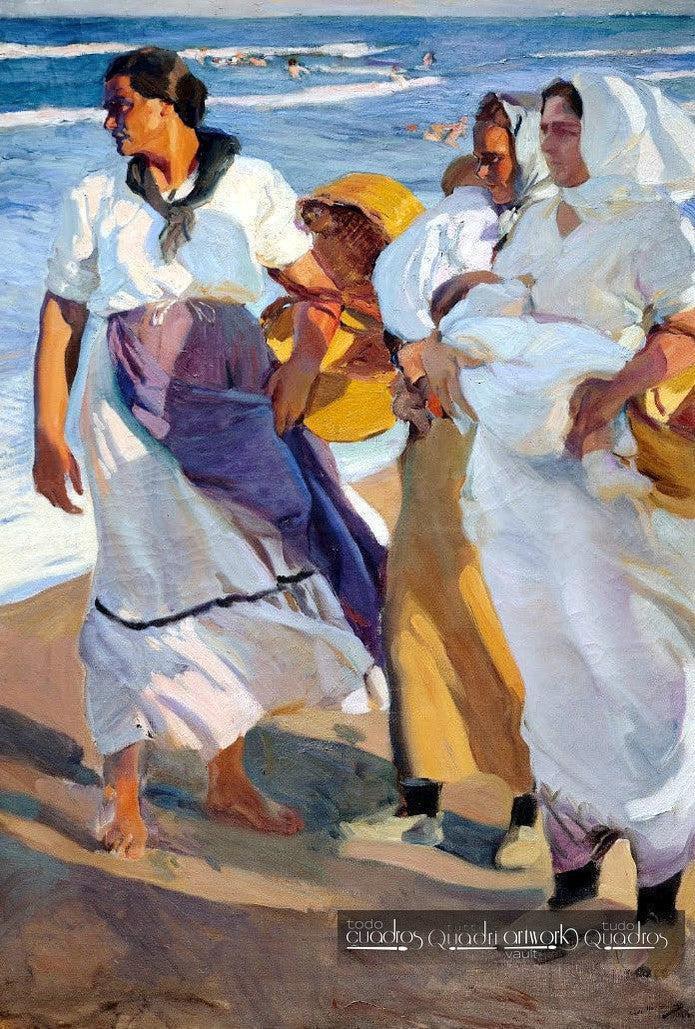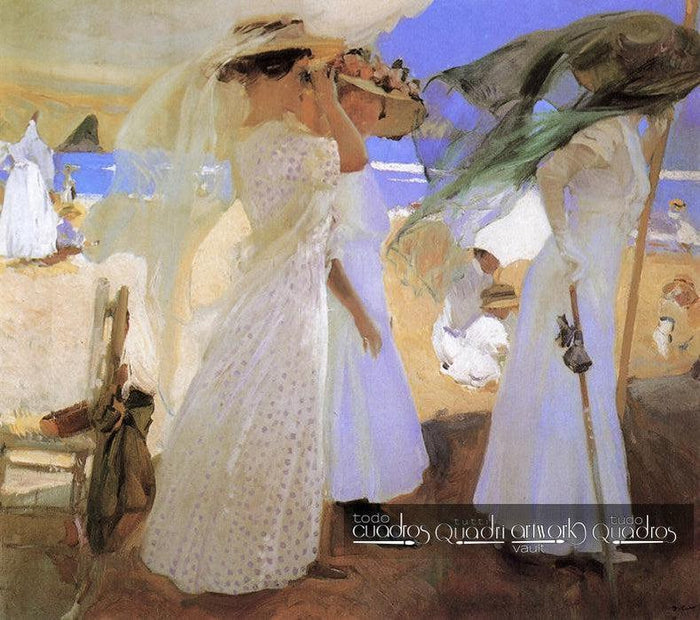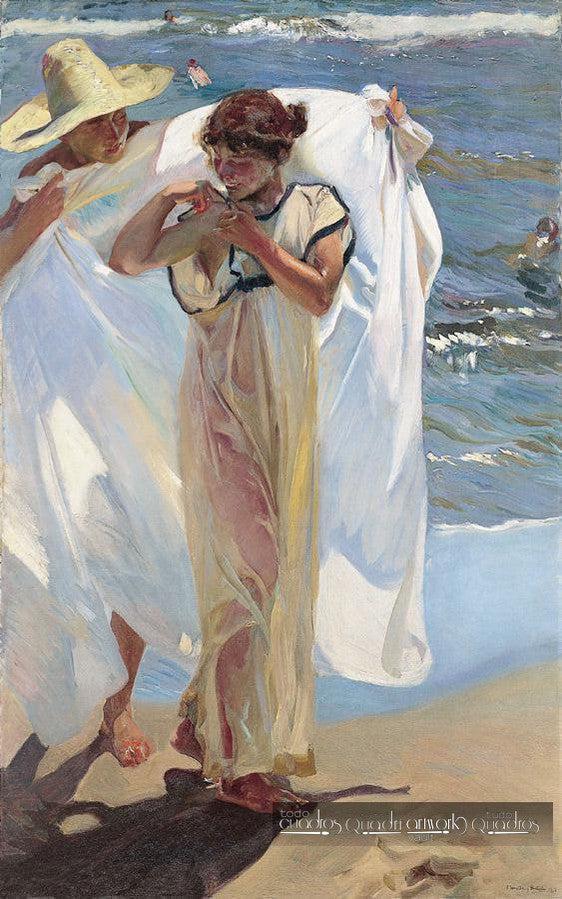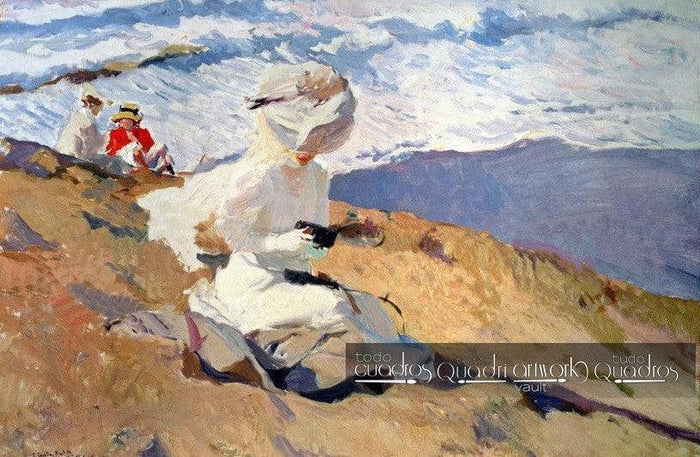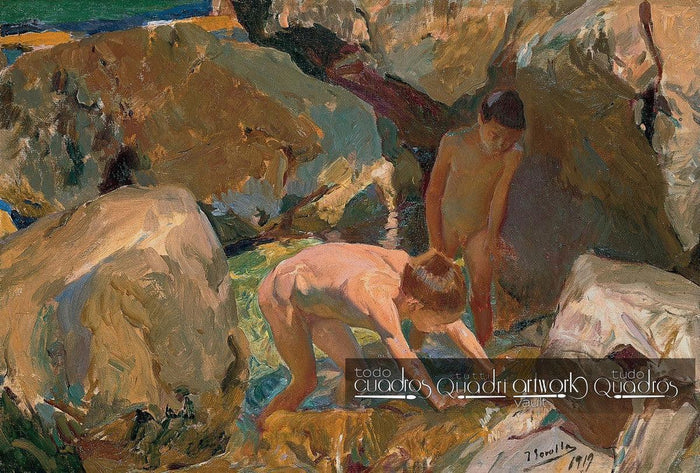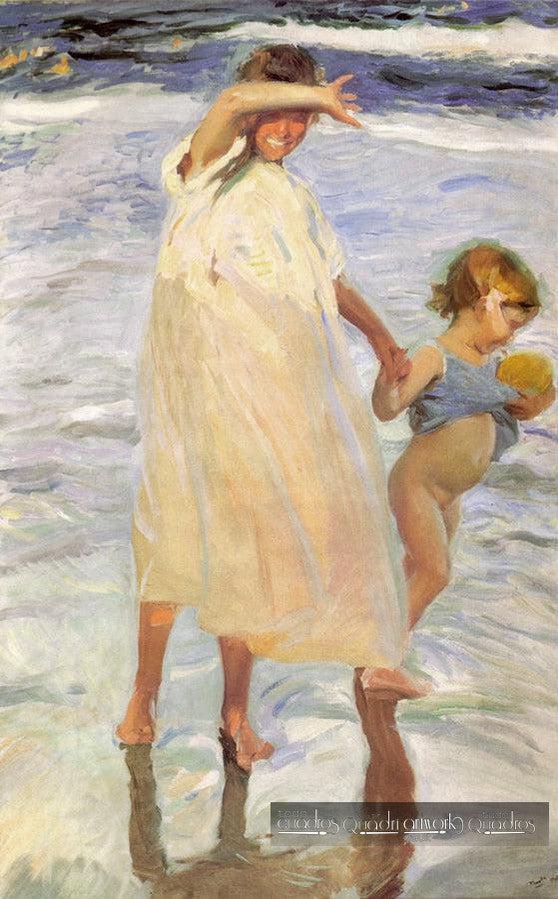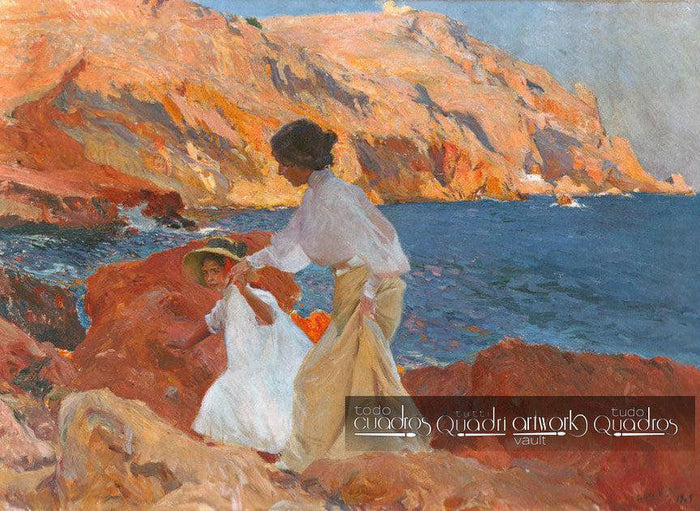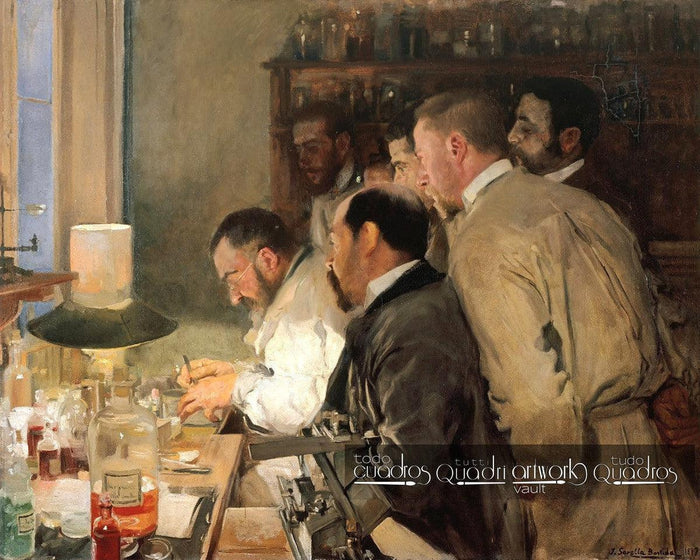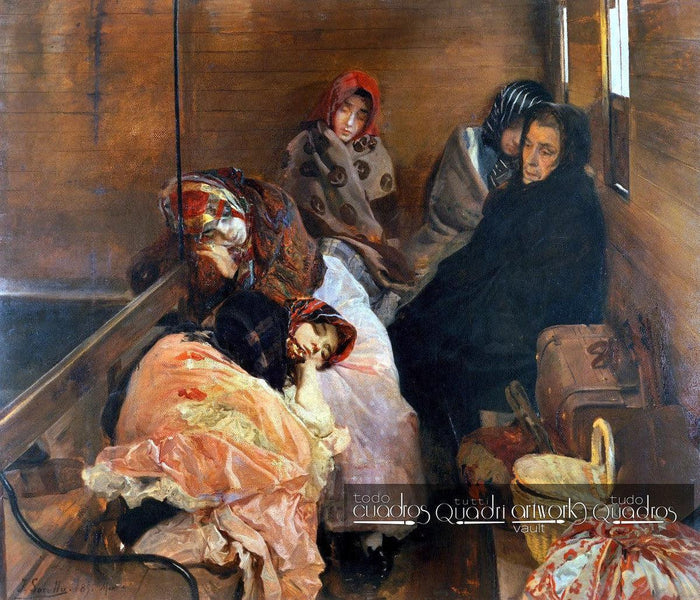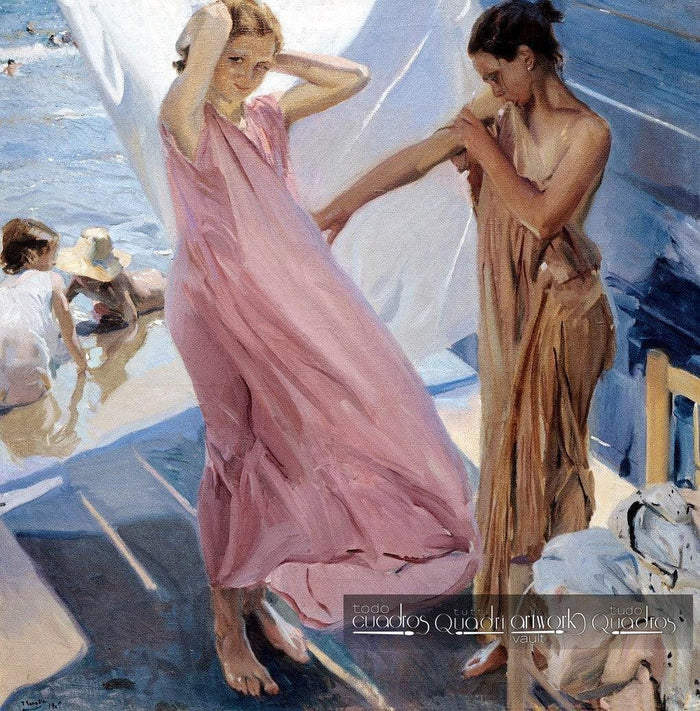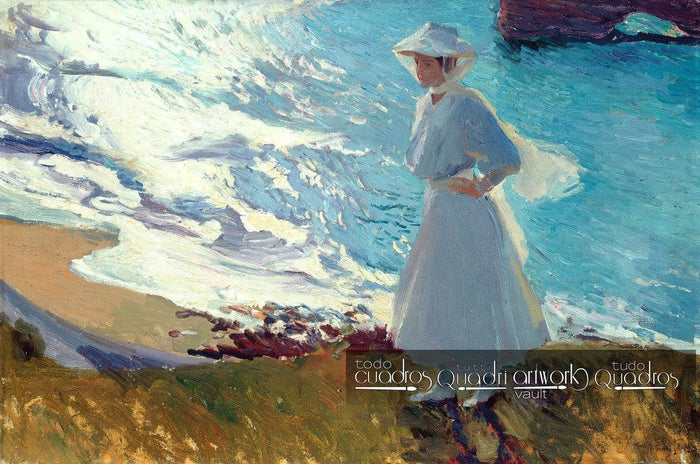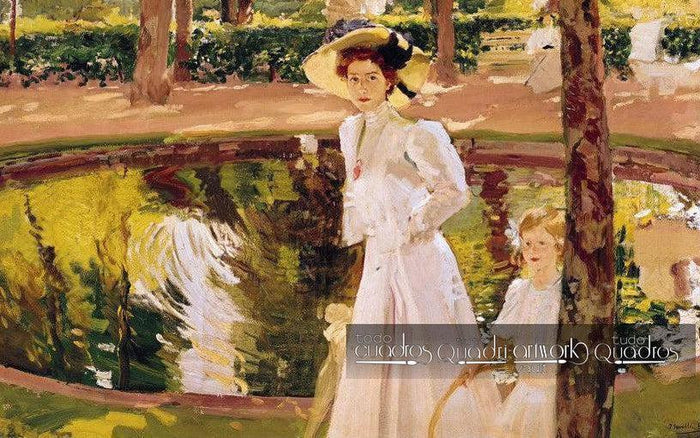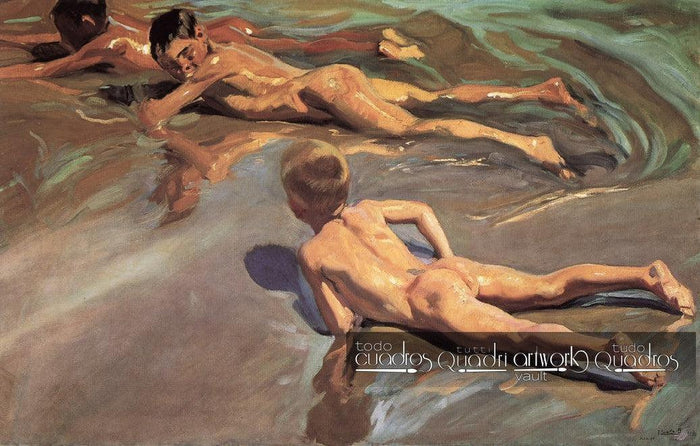Works by J. Sorolla y Bastida
1. Sewing the Sail
| Author: | Joaquín Sorolla |
|---|---|
| Original Title: | Cosiendo la vela |
| Type: | Painting |
| Style: | Luminism |
| Medium | Oil |
| Support: | Canvas |
| Year: | 1896 |
| Genre: | Costumbrism |
| Located: | Prado National Museum, Madrid. |
Sewing the Sail is an oil painting by Joaquín Sorolla y Bastida, created in 1896. It depicts a group of men and women sewing a boat’s sail on a terrace in Valencia, bathed in Mediterranean light. The work belongs to the artist’s costumbrista period, during which he masterfully portrayed everyday life and the traditions of the Valencian coast.
Read more2. Walk on the Beach
| Author: | Joaquín Sorolla |
|---|---|
| Original Title: | Paseo a orillas del mar |
| Type: | Painting |
| Style: | Luminism |
| Medium | Oil |
| Support: | Canvas |
| Year: | 1909 |
| Genre: | Costumbrism |
| Subject: | Valencia Beach |
| Located: | Sorolla museum, Madrid. |
This is one of the most iconic works by Joaquín Sorolla and a perfect synthesis of his luminous art. Painted in 1909, the scene depicts his wife Clotilde and his daughter María walking along the beach in Valencia, dressed in white garments that capture and reflect the brilliance of the Mediterranean sun. Sorolla transforms this intimate family moment into a composition of great elegance and balance, where light, color, and movement exist in perfect harmony.
Read more3. Seville Garden Grotto
| Author: | Joaquín Sorolla |
|---|---|
| Type: | Painting |
| Style: | Impressionism |
| Medium | Oil |
| Support: | Canvas |
| Year: | 1910 |
| Subject: | Rural |
| Located: | Sorolla museum, Madrid. |
Impressionist painting by Joaquín Sorolla y Bastida. The painting depicts a part of the Garden in the surroundings of the Alcazar of Seville.
5. Three Sails
| Author: | Joaquín Sorolla |
|---|---|
| Original Title: | Las tres velas |
| Type: | Painting |
| Style: | Luminism |
| Medium | Oil |
| Support: | Canvas |
| Year: | 1903 |
| Genre: | Costumbrism |
| Subject: | Valencia Beach |
| Located: | manos privadas |
6. The bathing hour
| Author: | Joaquín Sorolla |
|---|---|
| Original Title: | Niña entrando en el baño |
| Type: | Painting |
| Style: | Luminism |
| Medium | Oil |
| Support: | Canvas |
| Year: | 1915 |
| Subject: | Valencia Beach |
| Located: | Colección privada. |
Painting of a little girl running towards the sea in Valencia, picture painted by Joaquín Sorolla y Bastida.
7. The Little Sailing Boat
| Author: | Joaquín Sorolla |
|---|---|
| Original Title: | El balandrito |
| Type: | Painting |
| Style: | Luminism |
| Medium | Oil |
| Support: | Canvas |
| Year: | 1909 |
| Genre: | Costumbrism |
| Located: | Sorolla museum, Madrid. |
Painting titled The Little Sailing Boat, by Joaquín Sorolla y Bastida. It depicts a Young Boy playing with a Toy Sailboat in the sea.
8. Girls in the Sea
| Author: | Joaquín Sorolla |
|---|---|
| Original Title: | Niñas en el mar |
| Type: | Painting |
| Style: | Luminism |
| Medium | Oil |
| Support: | Canvas |
| Year: | 1909 |
| Subject: | Valencia Beach |
| Located: | Sorolla museum, Madrid. |
Work by Joaquín Sorolla y Bastida, belonging to the series of marine paintings made in Valencia, Spain.
9. Sea Idyll
| Author: | Joaquín Sorolla |
|---|---|
| Type: | Painting |
| Style: | Luminism |
| Medium | Oil |
| Support: | Canvas |
| Year: | 1908 |
| Genre: | Costumbrism |
| Subject: | Valencia Beach |
| Located: | Hispanic Society of America, New York |
10. After Bathing
| Author: | Joaquín Sorolla |
|---|---|
| Original Title: | After Bathing |
| Type: | Painting |
| Style: | Luminism |
| Medium | Oil |
| Support: | Canvas |
| Year: | 1915 |
| Genre: | Costumbrism |
| Located: | Sorolla museum, Madrid. |
11. The Fisherman
| Author: | Joaquín Sorolla |
|---|---|
| Type: | Painting |
| Style: | Luminism |
| Medium | Oil |
| Support: | Canvas |
| Year: | 1904 |
| Genre: | Costumbrism |
| Located: | manos privadas |
12. The Fishing
| Author: | Joaquín Sorolla |
|---|---|
| Type: | Painting |
| Style: | Luminism |
| Medium | Oil |
| Support: | Tela |
| Year: | 1919 |
| Genre: | Costumbrism |
| Located: | Hispanic Society of America, New York |
13. The Pink Robe
| Author: | Joaquín Sorolla |
|---|---|
| Type: | Painting |
| Style: | Luminism |
| Medium | Oil |
| Support: | Canvas |
| Year: | 1916 |
| Genre: | Costumbrism |
| Located: | Sorolla museum, Madrid. |
14. Breakwater, San Sebastian
| Author: | Joaquín Sorolla |
|---|---|
| Original Title: | Rompeolas, San Sebastián |
| Type: | Painting |
| Style: | Luminism |
| Medium | Oil |
| Support: | Canvas |
| Year: | 1918 |
| Genre: | Seascapes |
| Located: | Sorolla museum, Madrid. |
This painting depicts a summer evening (almost night) in the Basque city where residents gather to witness the majestic natural spectacle. The stormy and cloudy sky leads the artist to select from his palette a range of tones close to green and grey.
Sorolla demonstrates an extraordinary vision, capturing the slightest details and nuances, so that the painting shows, not only the image, but the entire atmosphere of the moment.
15. The Horse’s Bath
| Author: | Joaquín Sorolla |
|---|---|
| Type: | Painting |
| Style: | Luminism |
| Medium | Oil |
| Support: | Canvas |
| Year: | 1909 |
| Genre: | Costumbrism |
| Located: | Sorolla museum, Madrid. |
Replica of the painting The Horse's Bath by Joaquín Sorolla y Bastida. The work depicts a Young man taking his animal out of the sea after washing it.
16. Under the Awning
| Author: | Joaquín Sorolla |
|---|---|
| Original Title: | Bajo el Toldo, Playa de Zarauz |
| Type: | Painting |
| Style: | Luminism |
| Medium | Oil |
| Support: | Canvas |
| Year: | 1905 |
| Genre: | Costumbrism |
| Located: | Sorolla museum, Madrid. |
17. Time for a Bathe
| Author: | Joaquín Sorolla |
|---|---|
| Original Title: | La Hora del Baño |
| Type: | Painting |
| Style: | Luminism |
| Medium | Oil |
| Support: | Canvas |
| Year: | 1909 |
| Subject: | Valencia Beach |
| Located: | Sorolla museum, Madrid. |
This painting is part of the classic series where the artist portrayed a variety of characters in everyday situations, always around the Valencian coast.
A girl dressed in pink entering the beach, under the watchful eye of her caretaker, who is holding a baby in her arms.
Sorolla had a special predilection for painting children, and an astonishing ability and mastery in representing reflections on the wet sand, garments mixed with shadows and sunlight. This is one of the works where the most elements that the painter managed at his will combine.
18. Boats at Rest
| Author: | Joaquín Sorolla |
|---|---|
| Type: | Painting |
| Style: | Luminism |
| Medium | Oil |
| Support: | Canvas |
| Year: | 1915 |
Painting of empty boats moored on the riverbank, a work painted by Joaquín Sorolla y Bastida.
19. The Siesta
| Author: | Joaquín Sorolla |
|---|---|
| Original Title: | La Siesta |
| Type: | Painting |
| Style: | Luminism |
| Medium | Oil |
| Support: | Canvas |
| Year: | 1911 |
| Located: | Sorolla museum, Madrid. |
20. Skipping Rope
| Author: | Joaquín Sorolla |
|---|---|
| Original Title: | Saltando a la Comba, la Granja |
| Type: | Painting |
| Style: | Luminism |
| Medium | Oil |
| Support: | Canvas |
| Year: | 1907 |
| Located: | Sorolla museum, Madrid. |
21. Valencian Fisherwomen
| Author: | Joaquín Sorolla |
|---|---|
| Original Title: | Pescadoras Valencianas |
| Type: | Painting |
| Style: | Luminism |
| Medium | Oil |
| Support: | Canvas |
| Year: | 1915 |
| Genre: | Costumbrism |
| Located: | Sorolla museum, Madrid. |
22. Under the awning zarauz
| Author: | Joaquín Sorolla |
|---|---|
| Original Title: | Bajo el toldo, playa de Zarautz |
| Type: | Painting |
| Style: | Luminism |
| Medium | Oil |
| Support: | Canvas |
| Year: | 1910 |
| Subject: | Valencia Beach |
| Located: | Sorolla museum, Madrid. |
Painting of women dressed in white watching the sea under an awning on the beach of Zarautz, Basque Country. Painted by Joaquín Sorolla y Bastida.
23. After Bathing
Painting titled "After the Bath", painted by Joaquín Sorolla y Bastida in the year 1908. This painting depicts a Valencian youth wrapping a maiden after her bath in the sea. The attire of both is traditional of the city of Valencia at the beginning of the last century.
24. Capturing the moment
| Author: | Joaquín Sorolla |
|---|---|
| Original Title: | Instantánea |
| Type: | Painting |
| Style: | Luminism |
| Medium | Oil |
| Support: | Canvas |
| Year: | 1906 |
| Subject: | Valencia Beach |
| Located: | Sorolla museum, Madrid. |
"Capturing the moment", an impressionist painting by the Spanish Joaquín Sorolla y Bastida. The work depicts a woman dressed in white reading a book in front of the sea. The brushstrokes, colors, and landscapes belong to the unique pictorial style created by the artist.
25. Children Looking for Shellfish
| Author: | Joaquín Sorolla |
|---|---|
| Original Title: | Niños Buscando Mariscos |
| Type: | Painting |
| Style: | Luminism |
| Medium | Oil |
| Support: | Canvas |
| Year: | 1919 |
| Genre: | Costumbrism |
| Subject: | Valencia Beach |
| Located: | Santander Bank Collection, Madrid |
The work painted during the last phase of the artist.
The theme of the painting is recurrent in the painter's work, in fact it was the main subject he developed throughout his career: children playing, bathing, and posing on the beach. The jovial and innocent character of the work becomes even stronger under the contrasts of light, ochre nuances, and brightness in all elements: rocks, children, and water.
26. Two Sisters
27. Clotilde and Elena on the Rocks
| Author: | Joaquín Sorolla |
|---|---|
| Type: | Painting |
| Style: | Luminism |
| Medium | Oil |
| Support: | Canvas |
| Year: | 1905 |
| Subject: | Valencia Beach |
| Located: | Private collection |
Painting Clotilde and Elena on the Rocks, a work in which the Valencian painter portrays his wife and daughter walking on the rocks at the beach. Artist Joaquín Sorolla y Bastida.
28. Research
| Author: | Joaquín Sorolla |
|---|---|
| Original Title: | Una Investigación |
| Type: | Quadro |
| Style: | Luminism |
| Medium | Oil |
| Support: | Canvas |
| Year: | 1897 |
| Genre: | Costumbrism |
| Located: | Sorolla museum, Madrid. |
29. White Slave Trade
| Author: | Joaquín Sorolla |
|---|---|
| Original Title: | Trata de blancas |
| Type: | Painting |
| Style: | Luminism |
| Medium | Oil |
| Support: | Canvas |
| Year: | 1894 |
| Located: | Sorolla museum, Madrid. |
30. After Bathing
| Author: | Joaquín Sorolla |
|---|---|
| Original Title: | Después del Baño |
| Type: | Painting |
| Style: | Luminism |
| Medium | Oil |
| Support: | Canvas |
| Year: | 1909 |
| Genre: | Costumbrism |
| Located: | Sorolla museum, Madrid. |
31. María on the Beach at Biarritz
| Author: | Joaquín Sorolla |
|---|---|
| Original Title: | María en la Playa de Biarritz o Contraluz |
| Type: | Painting |
| Style: | Luminism |
| Medium | Oil |
| Support: | Canvas |
| Year: | 1906 |
| Genre: | Seascapes |
| Located: | Sorolla museum, Madrid. |
32. The Garden
| Author: | Joaquín Sorolla |
|---|---|
| Type: | Painting |
| Style: | Impressionism |
| Medium | Oil |
| Support: | Canvas |
| Year: | 1907 |
| Genre: | Period scene |
| Located: | Sorolla museum, Madrid. |
The painting "The Garden", a work of Spanish Impressionism, depicts a woman against a landscape background. Painted by Joaquín Sorolla y Bastida in 1907.
33. Boys on the Beach
| Author: | Joaquín Sorolla |
|---|---|
| Original Title: | Niños en la playa |
| Type: | Painting |
| Style: | Luminism |
| Medium | Oil |
| Support: | Canvas |
| Year: | 1910 |
| Genre: | Costumbrism |
| Subject: | Valencia Beach |
| Located: | Prado National Museum, Madrid. |
See it in the store under the section Sorolla oil paintings.
Related famous painters in Artwork-Vault:
↑Back to top
